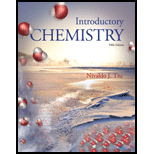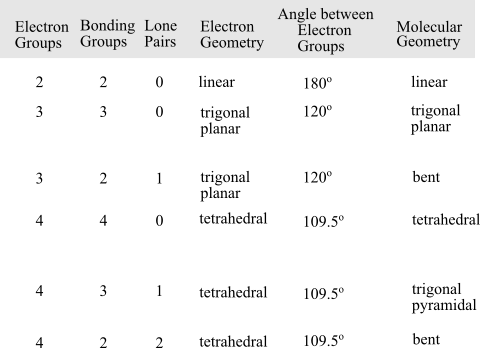
Interpretation: The formulas and space filling models of the given molecules are to be examined. The correctness of each structure is to be checked. The correct structure is to be sketched for incorrect structures.
Concept Introduction: A Lewis structure is used to represent the valence electrons and the bonds present in a molecule.
Dots in the Lewis structure represent the valence electrons.
Total number of electrons for Lewis structure can be calculated by summing the valence electrons of each atom in the molecule.
Once a Lewis structure is drawn, it is possible to identify the shape of the molecule using the VSEPR theory.
VSEPR stand for Valence Shell Electron Pair repulsion theory. It uses chemical formula, number of bonds and lone pairs to predict the shape of molecules.
The geometry of a molecule or a polyatomic ion is determined on the basis of the total number of electron groups, the number of bonding groups and the number of lone pairs. To determine the geometry of the molecule, follow the following table:

Want to see the full answer?
Check out a sample textbook solution
Chapter 10 Solutions
Introductory Chemistry (5th Edition) (Standalone Book)
- Compounds such as NaBH4, Al(BH4)3, and LiAlH4 are complexhydrides used as reducing agents in many syntheses.(a) Give the oxidation state of each element in these compounds.(b) Write a Lewis structure for the polyatomic anion in NaBH4, and predict its shape.arrow_forwardwhat is the shape of [Co(NH3)6]^3+ ?arrow_forwardArrange the following material according to the increasing tendency to lose an electron. (I.) glass, (II.) copper, (III.) fur, (IV.) Silkarrow_forward
- Which property of the third-row nonmetallic elementsmight be the one depicted below: (a) first ionizationenergy, (b) atomic radius, (c) electronegativity, (d) meltingpoint, (e) X¬X single-bond enthalpy?arrow_forwardFollow the directions of Question 1 for (a) IO2- (b) SiF4 (c) BrI3 (d) CN-arrow_forward
 Chemistry: The Molecular ScienceChemistryISBN:9781285199047Author:John W. Moore, Conrad L. StanitskiPublisher:Cengage Learning
Chemistry: The Molecular ScienceChemistryISBN:9781285199047Author:John W. Moore, Conrad L. StanitskiPublisher:Cengage Learning Chemistry by OpenStax (2015-05-04)ChemistryISBN:9781938168390Author:Klaus Theopold, Richard H Langley, Paul Flowers, William R. Robinson, Mark BlaserPublisher:OpenStax
Chemistry by OpenStax (2015-05-04)ChemistryISBN:9781938168390Author:Klaus Theopold, Richard H Langley, Paul Flowers, William R. Robinson, Mark BlaserPublisher:OpenStax ChemistryChemistryISBN:9781305957404Author:Steven S. Zumdahl, Susan A. Zumdahl, Donald J. DeCostePublisher:Cengage Learning
ChemistryChemistryISBN:9781305957404Author:Steven S. Zumdahl, Susan A. Zumdahl, Donald J. DeCostePublisher:Cengage Learning Chemistry: An Atoms First ApproachChemistryISBN:9781305079243Author:Steven S. Zumdahl, Susan A. ZumdahlPublisher:Cengage Learning
Chemistry: An Atoms First ApproachChemistryISBN:9781305079243Author:Steven S. Zumdahl, Susan A. ZumdahlPublisher:Cengage Learning
 Chemistry: Principles and PracticeChemistryISBN:9780534420123Author:Daniel L. Reger, Scott R. Goode, David W. Ball, Edward MercerPublisher:Cengage Learning
Chemistry: Principles and PracticeChemistryISBN:9780534420123Author:Daniel L. Reger, Scott R. Goode, David W. Ball, Edward MercerPublisher:Cengage Learning





